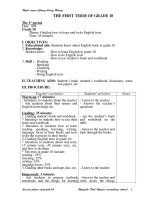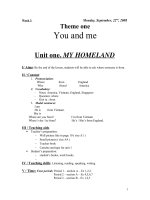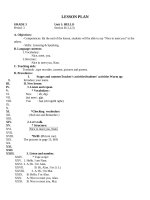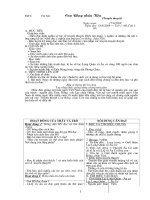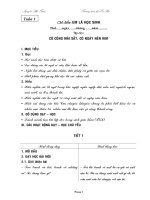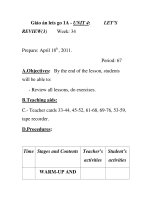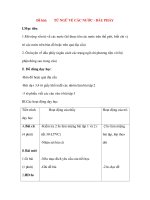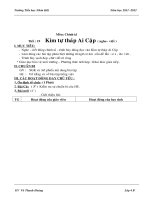Giáo án lets learn english book 1 lớp 3 HK1
Bạn đang xem bản rút gọn của tài liệu. Xem và tải ngay bản đầy đủ của tài liệu tại đây (401.37 KB, 84 trang )
ME AND MY
FRIENDS
Week: 1.
Date of teaching:
Thursday,
September 9
th
,
2013.
Period: 1
st
.
UNIT 1: HELLO
Lesson 1
I. Aims: Practice
greeting and self –
introducing.
II. Objectives:
- By the end
of this
lesson,
students
will be
able to
greet and
self –
introduce.
- Develop speaking skill.
III. Teaching methods:
- Communicative approach.
- Techniques:
+ Ask and answer (say individually)
+ Work in pairs/ groups.
+ Discuss.
IV. Teaching aids:
- Teacher’s aids: student’s and teacher’s book, word cards, pictures, tape, cassette,
puppets.
- Students’ aids: books, notebooks, workbooks.
V. Languages focus:
- Phonics: Hi/ Hello.
- Vocabulary: hi, hello
- Structures: Hello. I’m Mai. / Hi, Mai.
VI. Procedures:
Time Steps/Activities Work
arrangement
5’
10’
10’
I. Warm up: Chatting.
- Let Ss introduce some information about themselves
(maybe in Vietnamese) and introduces oneself in
English.
Example: Hello. I’m Duyen. (Hi. I am Duyen).
II. New lesson
1. Look, listen and repeat.
- Giving introduction of the text (set the scene): Mai and
Nam greet each other.
- Play the recording and asks Ss to listen to the tape twice.
- T asks Ss to listen and repeat in chorus three times.
- Let Ss practice the dialogue in pairs
- Gets some pairs to read it aloud.
- T gives a situation to present (using picture)
- T elicits the structures by asking Ss to speak out the
model sentence:
Hello. I’m Mai.
Hi, Mai. I’m Nam.
2. Look and say
- Have Ss look at the pictures a,b,c,d and introduce four
characters: Nam, Mai, Nga, Phong. (using the puppets).
- T models the dialogue (use a picture)
Nga: Hello, I’m Nga.
T-WC
T-WC
T-WC
Whole class,
group and
individual.
T-WC
Group work
Pair- work
T – whole
class
I’m + name (I’m = I am)
10
4’
Phong: Hello, I’m Phong.
- Have Ss to repeat the sentences in the bubbles a few
times
- Call on one pair and ask them to pretend to be Nam and
Mai.
- Call on one more pair to be Nga and Phong and do the
same way.
- Have the class repeat all the phrases
- Have Ss to work in pairs: Nam, Mai, Nga and Phong.
- Monitor the activity, check the pronunciation (sound,
assimilation of sound and intonation) and offer help
when necessary.
- Call on some pairs to perform the task at the front of the
class. Others observe and comment.
- Make some questions to check Ss’ comprehension of
language
- Have the whole class repeat all the phrases to reinforce
their pronunciation.
3. Let’s talk.
- Have Ss look at the pictures on page 7 and identify the
characters in the pictures.
- Point to Picture a, ask Ss to guess what the girls would
say to greet each other.
A: Hello, I’m Mai.
B: Hi, Mai. I’m Nga.
- Have Ss to repeat the sentences in the bubbles a few
times before let them practice freely.
- Have Ss to work in pairs (use the names in their books or
the real names to practice.
- Monitor the activity and offer help when necessary/
correct typical pronunciation errors.
- Call on a pair to demonstrate at the front of the class.
- Have the whole class repeat all the phrases to reinforce
their pronunciation.
III. Summary and Home- link:
- Consolidate the content of the lesson
T – whole
class
Pair- work
T – whole
class
Pair – work
T – whole
class
- Learn and write new words and structures.
- Prepare for the next lesson
Week: 1 Date of teaching: Friday, September 10
th
, 2013.
Period: 2
nd
.
UNIT 1: HELLO
Lesson 2
I. Aims: Practice listening and numbering the pictures about greeting “Hello/Hi” and self
– introducing.
II. Objectives:
- By the end of this lesson, students will be able listen to the dialogue and tick on the
pictures about greeting “Hello/ Hi” and self – introducing.
- Develop listening, reading and writing skill.
III. Teaching methods:
- Communicative method.
- Techniques: + Work in pairs and individually
+ Ask and answer.
+ Work in groups, discuss.
IV. Teaching aids:
- Teacher’s aids: pictures, word cards, extra board, tape, cassette.
- Student’s aids: book, notebook, workbook.
V. Language focus:
- Revision the structures: Hi/ Hello. I am/ I’m + name.
- Phonics: Hi, Hello
VI. Procedures:
Time Steps/Activities
Work
arrangement
5’
I. Warm up: Noughts and crosses
II. New lesson
T-WC
I Nga Hello
Nam am Mai
Hi Phong Hi, Mai
10’
10’
1. Listen and repeat
- Have Ss open the book page 8, look at the words hello, hi
and notice the letter colored differently in both words.
- Produce the sound of the letter h in the word hello and that
in the word hi.
- Ask Ss to say what they think about when they hear the
sound
- Play the recording all the way through for Ss to listen
while they are reading the chant in their books
- Call on a group of six: three of them to repeat each line of
the chant, other three clap the syllables
- Have Ss practice the chant in groups and clap the
syllables.
- Monitor the activity and offer help when necessary/
correct typical pronunciation errors.
- Call on a group to recite the chant. The others clap the
syllables
- Make a few questions to check Ss’ comprehension of
language
- Have the whole class recite the chant to reinforce their
pronunciation.
- Have Ss circle all the words containing the focused sounds
hello and hi in the chant.
2. Listen and number
- Have Ss look at Pictures a, b, c and d on Page 8.
- Elicit the identification of the characters in the pictures
and the characters’ words.
- Ask Ss to listen to the recording and match the
information they hear to the pictures and number the
pictures.
- 1
st
:Play the recording all the way through for Ss to listen
while they are looking the pictures in their books
- 2
nd
: play the recording for Ss to listen and number.
- 3
rd
: play the recording for Ss to check their answers.
- Have Ss trade their answers in pairs for correction
- Ask some questions to ensure Ss’ comprehension of the
listening text.
Transcript:
1. Hello. I’m Nam.
2. Hi. I’m Phong.
3. Hi. I’m Quan.
T-WC
T-WC
Whole class,
group and
individual.
T-WC
Group work
Pair- work
10’
5’
4. Hello. I’m Hoa.
Answers: 1 – d; 2 – c; 3 – b; 4 – a.
3. Read and match.
- T introduces the topic “you are going to read the sentences
to get the information in order to match the pictures to the
text”.
- Ask Ss to predict “What is what”.
- 1
st
reading: Ss read the sentences individually and check
their prediction.
- 2
nd
reading: Ss do the task (match the sentence with a
appropriate picture.)
- Monitor the activity and offer help when necessary
- Have Ss trade the answers in pairs for correction
- Call on some Ss to report their answers. Others listen and
comment.
- Make a few questions to check Ss’ comprehension of the
sentences.
- Have the whole class read each sentence in chorus to
reinforce their pronunciation
Answers: 1 – d; 2 – c; 3 – b; 4 – a.
III. Summary and Home- link:
- Consolidate the content of lesson.
- Learn to greet each other and self – introduce, using hello/
hi.
- Practice the sound h as in hello and hi.
- Recite the chant on page 7.
T – whole
class
T – whole
class
Pair- work
T – whole
class
Week: 2 Date of teaching: Thursday, September 16
th
, 2013.
Period: 3
rd
UNIT 1: HELLO
Lesson 3
I. Aims: Practice saying goodbye.
II. Objectives:
- By the end of this lesson, Students will be able to say goodbye.
- Develop speaking and listening skill.
III. Teaching methods:
- Communicative method.
- Techniques: + Work in pairs
+ Work in groups, discuss.
+ Ask and answer.
IV. Teaching aids:
- Teacher’s aids: Tape cassette, pictures, poster, flashcards.
- Students’ aids: book, notebook, workbook.
V. Languages focus:
- Structures: Nice to meet you. / Nice to meet you too.
VI. Procedures:
Time Steps/Activities Work
arrangement
1’
5’
10’
10’
I. Warm up:
Chatting
- T asks Ss to repeat the greeting and introducing
oneself.
- T sets the scene.
II. New lesson.
1. Listen and repeat.
- Have Ss to look at the book at page 10.
- Elicit the character and have Ss guess what they are
saying.
- Set the scene: we are going to review phrases saying
hello and bye.
- Have Ss listen to the recording as they read the lines in
the speech bubbles
- Play the recording again for Ss to repeat the lines in the
speech bubbles two times.
- Divide the class into two groups. One repeat Mai’s part
and the other repeat Nam’ part.
- Play the recording again for the whole class to repeat
each line in the speech bubbles to reinforce their
pronunciation.
- Elicit the structure
2. Look and say.
- Have Ss look at the pictures a, b, c and d on page 10
- Elicit the characters in the pictures and their names. Ask
Ss to guess and complete the speech bubbles.
- T models/ allocates the parts of characters Mai and Nam
to Ss
- Ask them to act out the dialogue1. Repeat the step with
T – whole
class
T – whole
class
T – whole
class
Whole class
Groups
individually
Group work
10’
4’
some other pairs for pictures b, c, d
- Have Ss practice acting out the dialogue in pairs, using
the pictures.
- Monitor the activity and offer help. Correct
pronunciation errors (stress, assimilation of sounds,
intonation) when necessary.
- Call on some pairs to perform the task at the front of the
class. The others observe and give comments.
- Have the whole class repeat all the phrases in chorus to
reinforce their pronunciation.
3. Write.
- Get Ss to identify the characters in the pictures on page
11 and what they are saying.
- Tell Ss that they are going to read and get information to
write the missing words in dialogue 1 and 2.
- Ss read silently and complete the dialogues.
- Ss trade their answers within pairs or groups for
correction
- Ask Ss to read the answers aloud to the class. The others
listen and give comments.
Answers:
a. Hi, I’m
b. boy; girl
- Make some questions to check Ss’ comprehension of
the reading text.
- Have the whole class read each line of the dialogues
chorally to reinforce their pronunciation.
III. Summary and Home- link:
- Consolidate the content of the lesson.
- Ask Ss to learn and write new words and structure.
- Prepare for Section B: 4, 5, 6, 7.
Pair - work
T – whole
class
Individually
Pair - work/
Group work
Whole class
T-WC
Week: 2 Date of teaching: Friday, September 17
th
, 2013.
Period: 4
th
.
UNIT 2
MY NAME IS …
Lesson 1
I. Aims: To understand about making and responding to instructions.
II. Objectives:
- By the end of this lesson, students will be able to make and respond to instructions
- Develop writing, reading skill.
III. Teaching method:
- Communicative method.
- Techniques:
- Ask and answer
- Work in pairs and individually.
- Work in groups, discuss.
IV. Teaching aids:
- Teacher’s aids: audio, stickers, puppets, flashcards.
- Students’ aids: book, notebook, workbook.
V. Languages focus:
Sentence patterns:
- Hello, I’m Mai.
- Hi, Mai. I’m Nam.
VI. Procedures:
Time Steps/Activities Work
arrangement
5’
10’
12’
I. Warm up:
- T asks some pairs to greet and introduce oneself.
S1: Hello. I’m Mai S2: Hi, Mai. I’m Nam
II. New lesson.
1. Look, listen and repeat.
- Ask Ss to identify the characters in the picture on page 12
and what they are saying.
- Set the scene “you are going to listen to hear Nam and
Mai greet each other.
- Play the recording and asks Ss to listen to the tape twice.
- T asks Ss to listen and repeat in chorus two times.
- Call on one pair. One repeats Mai’s part, the other repeats
Nam’s part.
- Have whole class repeat all the phrases a few times to
reinforce their pronunciation.
2. Look and say
- Have Ss look at the pictures a and b
- Ask them to identify the characters in the pictures and
what they should say. Fill the bubbles and have Ss to
repeat the lines a few times
- T models the dialogue
Assign a pair to pretend to be Mai and tom in picture a
Mai: Hello. I’m Mai.
Tom: Hello, Mai. I’m Tom.
T-WC
Pair- work
T – whole
class
T
T-WC
Pair- work
T- whole class
10’
3’
Have one repeat Mai’s part, the other Tom’s part. Then
have the pair swap their parts.
Repeat the step with a few more pairs.
- Ask Ss to practice making and responding to introductions
using picture a and b
- Monitor the activity, check the pronunciation (sound,
assimilation of sound and intonation) and offer help when
necessary.
- Call on some pairs to perform the task at the front of the
class. Others observe and comment.
- Make some questions to check Ss’ comprehension of
language
- Have the whole class repeat all the phrases to reinforce
their pronunciation.
3. Talk
- Have Ss look at the pictures on page 13 and identify the
characters in the pictures.
- Point to Picture a, ask Ss to guess what the girls should
say to the boy and vice versa.
- Fill in the speech bubbles with the correct phrases
prompted by Ss
- Have Ss to repeat the sentences in the bubbles a few times
before let them practice freely. (use the pictures in their
books or role – play the exchanges
- Have Ss to work in pairs to practice acting the greeting.
- Monitor the activity and offer help when necessary/
correct typical pronunciation errors.
- Call on a pair to demonstrate at the front of the class.
- Have the whole class repeat all the phrases to reinforce
their pronunciation.
III. Summary and Home- link:
- Encourage Ss to for Unit 2- Section 2
T- whole class
T- whole class
Group work
Individually.
Group work
T- whole class
Week: 3 Date of teaching: Thursday, September 23
rd
, 2013.
Period: 5
th
UNIT 2
MY NAME IS …
Lesson 2
I. Aims: Practice listening and ticking the pictures about greeting “Hello/Hi” and saying
goodbye.
II. Objectives:
- By the end of this lesson, students will be to greet and say goodbye (review).
- Develop listening, reading and writing skill.
III. Teaching methods:
- Communicative method.
- Techniques: + Work in pairs and individually
+ Ask and answer.
+ Work in groups, discuss.
IV. Teaching aids:
IV. Teacher’s aids: pictures, word cards, audio, puppets, flashcards.
V. Student’s aids: book, notebook, workbook.
V. Language focus:
VI. Revision the structures: Hi/ Hello. I am/ I’m + name.
Bye/ Goodbye.
How do you spell your name?
L – I – N – D – A.
VII. Phonics: Linda Nam
VI. Procedures:
Time Steps/Activities Work
arrangement
1’
5’
10’
1. Warm up: Noughts and crosses
2. New lesson:
1. Listen and repeat
- Have Ss open the book page 14, look at the words Linda
and Nam and notice the letter colored differently in both
words.
- Set the scene: “you are going to learn how to produce the
sound of the letter l in the word Linda and n in the word
Nam
- Produce the sound l and n a few times.
T-WC
T-WC
I Nga Hello
Nam am Goodbye
Hi Bye Mai
10’
- Teach the new phrases How do you spell + name? – Then
show them how to spell Nam and Linda and some other
names.
- Play the recording all the way through for Ss to listen
while they are reading the chant in their books
Linda Nam
I’m Linda.
How do you spell Linda?
L – I – N – D – A.
I’m Nam.
How do you spell Nam?
N – A – M.
- Call on a group of six: three of them to repeat each line of
the chant, other three clap the syllables
- Have Ss practice the chant in groups and clap the
syllables.
- Monitor the activity and offer help when necessary/
correct typical pronunciation errors.
- Call on a group to recite the chant. The others clap the
syllables
- Make a few questions to check Ss’ comprehension of
language
- Have the whole class recite the chant to reinforce their
pronunciation.
2. Listen and tick.
- Have Ss look at Pictures 1a, b; 2a, b and d on Page 14
- Identify the characters and guess what they are saying.
- Set the scene: “you are going to listen to the recording,
match the information they hear to the pictures and tick
the box in the appropriate picture.
- 1
st
:Play the recording all the way through for Ss to listen
while they are looking the pictures in their books
- 2
nd
: play the recording for Ss to listen and tick the correct
pictures.
- 3
rd
: play the recording for Ss to check their answers.
- Have Ss trade their answers in pairs for correction
- Ask some questions to ensure Ss’ comprehension of the
listening text.
Transcript
3. Mai: How do you spell your name?
Tony: T – O – N – Y.
T-WC
Whole class,
group and
individual.
T-WC
Group work
Pair- work
10’
4’
Mai: Sorry?
Tony: Tony. T – O – N – Y.
4. Phong: How do you spell your name?
Linda: L – I – N – D – A.
Phong: Sorry?
Linda: L – I – N – D – A.
Answers: 1 – a: 2 – b.
3. Read and match.
- Ask Ss to identify the characters in the pictures on page
15.
- Set the scene: “you are going to read the dialogues to get
the information in order to match the pictures to the
appropriate dialogues.”
- Have a revision of the language: “How do you spell your
name?” – “L – I – N – D – A.”
- Ask Ss to read the dialogues and do the task (match the
sentence with a appropriate picture.)
- Monitor the activity and offer help when necessary
- Have Ss trade the answers in pairs for correction
- Call on some Ss to report their answers. Others listen and
comment.
- Make a few questions to check Ss’ comprehension of the
sentences.
- Have the whole class read each sentence in chorus to
reinforce their pronunciation
Answers: 1 – b; 2 – a
5. Summary and Home- link:
- Ss have revised how to greet and say goodbye
- Say the letters in the alphabet, using How do you spell
your name?
- Produce the sound of the letter l in Linda and that the
letter n in Nam.
- Sing The ABC Song on page at home.
T – whole
class
T – whole
class
Pair- work
Individually
T – whole
class
Week: 3 Date of teaching: Friday, September 24
th
, 2013.
Period: 6
th
UNIT 2
MY NAME IS …
Lesson 3
I. Aims: Practice spelling simple names.
II. Objectives:
- By the end of this lesson, Students will be able to spell simple names.
- Develop speaking and listening skill.
III. Teaching methods:
- Communicative method.
- Techniques: + Work in pairs
+ Work in groups, discuss.
+ Ask and answer.
IV. Teaching aids:
- Teacher’s aids: pictures, word cards, audio, puppets, flashcards.
- Students’ aids: book, notebook, workbook.
V. Languages focus:
- Structures: How do you spell your name?
L – I – N – D – A.
VI. Procedures:
Time Steps/Activities Work
arrangement
1’
5’
10’
I. Class organization.
II. New lesson.
1. Warm up: Chatting
- T asks Ss to repeat the greeting and introducing
oneself.
- T sets the scene.
2. Listen and repeat.
- Have Ss to look at the book at page 16; identify the
characters in the picture and what they are doing.
- Set the scene: “we are going to learn how to spell
names and recall the alphabet.”
- Use a poster to set up the situation
- Have Ss listen to the recording as they read the lines in
the speech bubbles
- Play the recording again for Ss to repeat the dialogue
two times.
- Divide the class into two groups. Allocate the line of
Nam and Tom to Ss of each group
T – whole
class
T – whole
class
Whole class
Groups
10’
- Have one group repeat Nam’s part and the other Tom’s
part.
- Play the recording again for the whole class to repeat
each line in the speech bubbles to reinforce their
pronunciation.
3. Look and say
- Have Ss look at the pictures a, b, c and d on page 16
- Elicit the characters in the pictures and their names.
- Set the scene “ we are going to practice spelling
names”
- Ask Ss to guess and complete the speech bubbles.
- T models the dialogue
Assign a pair to pretend to be the characters in the
pictures.
Ask the pair to act out the question and answer
about spelling. Repeat the step but have the pair
swap their parts.
Continue the activities with sonme pairs.
- Ask Ss to practice asking and answering
- Monitor the activity, check the pronunciation (sound,
assimilation of sound and intonation) and offer help
when necessary.
- Call on some pairs to perform the task at the front of the
class. Others observe and comment.
- Have the whole class repeat the question and answer in
chorus to reinforce their pronunciation.
4. Write.
- Get Ss to identify the characters in the pictures on page
17 and what they are saying.
- Tell Ss that they are going to read and get information to
write the missing words in task 1 and 2.
- Ss read silently and complete the sentences.
- Monitor the activity and offer help when necessary
- Ss trade their answers within pairs or groups for
correction
- Ask some Ss to read their answers aloud to the class.
The others listen and give comments.
Answers:
a. Mai; Tony.
b. L – I – N – D – A.
- Make some questions to ensure Ss’ comprehension of
individually
Group work
Pair - work
Pair - work/
Group work
Individually
4’
the writing text.
- Have the whole class read each line of the dialogues
chorally to reinforce their pronunciation.
III. Summary
- Ss have learnt to ask and answer about names and to
spell simple names, using How do you spell your name?
IV. Home - link
- Ss spell their own names and the names of their family
members at home.
T – whole
class
T – whole
class
Week: 4 Date of teaching: Thursday, October 30
th
, 2013.
Period: 7
th
.
UNIT 3
HOW ARE YOU?
Lesson 1
I. Objectives:
- By the end of this lesson, students will be able to saying goodbye (review).
- Develop writing, reading skill.
II. Teaching method:
- Communicative method.
- Techniques:
- Work in pairs and individually.
- Work in groups, discuss.
III. Teaching aids:
- Teacher’s aids: audio, stickers, puppets, flashcards.
- Students’ aids: book, notebook, workbook.
IV. Languages focus:
Vocabulary: how, thank, thanks, fine, and.
Sentence patterns:
- How are you?
I’m fine, thank you. And you?
I’m fine, thanks.
V. Procedures:
Time Steps/Activities Work
arrangement
5’ I. Warm up: T-WC
10’
12’
- Have Ss to find out the names of the Ss.
L A N A B C D E
A V D E F M U F
B X P L R L T G
C Z H M W I S H
D T O N Y N Q I
E Y N O P D P J
F H G I J A O K
U X Y Z N A M L
V T X Q P O N M
- Answers: Lan, Phong, Tony, Nam, Linda.
- Ask Ss work in pairs:
S1: Hello. I’m Nam.
S2: Hi, Nam. I’m Tom.
II. New lesson.
1. Look, listen and repeat.
- Ask Ss to identify the characters in the picture on page
18 and what they are saying.
- Set the scene “you are going to review some phrases of
greeting and learn some more.” (use two puppets to
present the situation)
- Explain the situation and the use of the titles Mr, Mrs
and Miss
- Play the recording and asks Ss to listen to the tape twice.
- T asks Ss to listen and repeat in chorus two times.
- Hold up the specific character puppets in the air / point
to each character and tell the whole class to say the
appropriate line in the dialogue.
- Have whole class repeat all the phrases a few times to
reinforce their pronunciation.
Note:
• Children do not tend to ask each other How are you?
(That is something adults do to each other and to
children, but not child to child
• Thanks is an informal expression of thank you.
2. Look and say
- Have Ss look at the pictures a and bon page 18.
- Ask them to identify the characters in the pictures, recall
the greeting phrases.
Pair- work
T – whole
class
T
T-WC
Pair- work
T- whole
class
T- whole
class
T- whole
class
10’
- Point to Picture a, ask Ss to guess what each character
should say. Fill the speech bubbles with correct phrases
prompted by the Ss and have Ss to repeat the lines a few
times
- T models the dialogue
Assign a pair to pretend to be Tom and Mrs Lan in
picture a
Mrs Lan: How are you, Tom?
Tom: I’m fine, thank you. And you?
Mrs Lan: Fine, thanks.
Have one repeat Mrs Lan’s part, the other
Tom’s part. Then have the pair swap their parts.
Repeat the step with a few more pairs.
- Ask Ss to act the dialogue using picture a and b
- Monitor the activity, check the pronunciation (sound,
assimilation of sound and intonation) and offer help
when necessary.
- Call on some pairs to perform the task at the front of the
class. Others observe and comment.
- Have the whole class repeat all the phrases to reinforce
their pronunciation.
3. Talk
- Have Ss look at the pictures on page 19 and identify the
characters in the pictures.
- Recall the titles Mr., Mrs., Miss.
- Point to Picture a, ask Ss to guess what the characters
should say.
- Fill in the speech bubbles with the correct phrases
prompted by Ss
A: How are you?
B: I’m fine, thank you. And you?
A: Fine, thanks.
- Have Ss to repeat the lines in the bubbles a few times
before let them practice freely. (use the characters in their
books to practice or role play the greeting phrases.
- Have Ss to work in pairs to practice acting the greeting.
- Monitor the activity and offer help when necessary/
correct typical pronunciation errors.
- Call on a pair to demonstrate at the front of the class.
- Have the whole class repeat all the phrases to reinforce
their pronunciation.
Group work
T – whole
class
Pair – work
T- whole
class
Group work
Pair – work
3’ III. Summary and Home- link:
- Encourage Ss to prepare for Unit 3 - Lesson 2.
T – whole
class
Week: 4 Date of teaching: Friday, October, 1
st
, 2013.
Period: 8
th
UNIT 3
HOW ARE YOU?
Lesson 2
I. Objectives:
- By the end of this lesson, students will be to greet.
- Develop listening, reading and writing skill.
II. Teaching methods:
- Communicative method.
- Techniques: + Work in pairs and individually
+ Work in groups, discuss.
III. Teaching aids:
- Teacher’s aids: pictures, word cards, audio, puppets, flashcards.
- Student’s aids: book, notebook, workbook.
IV. Language focus:
Phonics: hello thanks
Vocabulary: how, thank, thanks, fine, and.
Sentence patterns:
- How are you?
I’m fine, thank you. And you?
I’m fine, thanks.
V. Procedures:
Time Steps/Activities Work
arrangement
5’
10’
10’
I. Warm up: Let’s Ss chant ( L2 – 4)
- Play the recording
II. New lesson:
1. Listen and repeat
- Have Ss open the book page 14, look at the words Linda
and Nam and notice the letter colored differently in both
words.
- Set the scene: “you are going to learn how to produce the
sound of the letter l in the word hello and a in the word
thanks
- Produce the sound l and n a few times.
- Teach the new phrases How do you spell + name? – Then
show them how to spell Nam and Linda and some other
names.
- Play the recording all the way through for Ss to listen
while they are reading the chant in their books
- Call on a group of six: three of them to repeat each line of
the chant, other three clap the syllables
- Have Ss practice the chant in groups and clap the
syllables.
- Monitor the activity and offer help when necessary/
correct typical pronunciation errors.
- Call on a group to recite the chant. The others clap the
syllables
- Make a few questions to check Ss’ comprehension of
language
- Have the whole class recite the chant to reinforce their
pronunciation.
2. Listen and tick.
- Have Ss look at Pictures 1a, b; 2a, b and d on Page 20
- Identify the characters and their relationship.
- Set the scene: “you are going to listen to the recording,
match the information they hear to the pictures and tick
the box in the corner of the correct picture
- 1
st
:Play the recording all the way through for Ss to listen
while they are looking the pictures in their books
- 2
nd
: play the recording for Ss to listen and tick the correct
pictures.
- 3
rd
: play the recording for Ss to check their answers.
- Have Ss trade their answers in pairs for correction
- Ask some questions to ensure Ss’ comprehension of the
T – whole
class
T – whole
class
T – whole
class
Whole class,
group and
T – whole
class
Individually
Pair- work
Week: 5 Date of teaching: Monday, October 7
th
, 2013.
Period: 9
th
UNIT 3
HOW ARE YOU?
Lesson 3
I. Objectives:
- By the end of this lesson, Students will be able to greet (review), using the language
they have learnt.
- Develop speaking and listening skill.
II. Teaching methods:
- Communicative method.
- Techniques: + Work in pairs
+ Work in groups, discuss.
+ Ask and answer.
III. Teaching aids:
- Teacher’s aids: pictures, word cards, audio, puppets, flashcards.
- Students’ aids: book, notebook, workbook.
IV. Languages focus:
Vocabulary: how, thank, thanks, fine, and.
Sentence patterns:
- How are you?
I’m fine, thank you. And you?
I’m fine, thanks.
V. Procedures:
Time Steps/Activities Work
arrangement
5’
10’
I. Warm up
Let’s Ss chant in two groups. Which is more correct is the
winner.
II. New lesson.
1. Listen and repeat.
- Have Ss to look at the book at page 22; identify the
characters in the picture.
- Make a few questions to check Ss’ comprehension of
the dialogue.
T – whole
class
T – whole
class
10’
10’
- Set the scene: “we are going to review greeting phrases
that they have learnt in the previous lesson.”
- Play the recording all the way through for Ss to listen
and read the text. Mime the dialogue.
- Play the recording again for Ss to repeat the dialogue a
few tome to reinforce their pronunciation.
2. Look and say
- Have Ss look at the pictures a, b, c and d on page 22
- Elicit the characters in the pictures and their names.
- Tell them to guess and respond to the first character.
Then fill the speech bubbles with the correct phrases
prompted by Ss.
- Have Ss repeat a few times.
- T models the dialogue
Assign a pair to pretend to be Linda and Miss Hien
to act out the dialogue.
Repeat the step but have the pair swap their parts.
- Have the whole class repeat all the phrases.
- Ask Ss to practice in pairs
- Monitor the activity, check the pronunciation (sound,
assimilation of sound and intonation) and offer help
when necessary.
- Call on some pairs to perform the task at the front of the
class. Others observe and comment.
- Have the whole class repeat the question and answer in
chorus to reinforce their pronunciation.
3. Write.
- Get Ss to identify the characters in the pictures on page
23
- Ask them to talk about the situation in each picture.
- Tell Ss that they are going to read and get information to
write the missing words in task in the dialogue, using
those from the frame on the top of the page.
- Ss read silently and complete the sentences.
- Monitor the activity and offer help when necessary
- Ss trade their answers within pairs or groups for
Whole class
T – whole
class
Pair – work
T – whole
class
Individually
3’
2’
correction
- Ask some Ss to read their answers aloud to the class.
The others listen and give comments.
Answers:
a. Hi
b. How
c. thank
d. thanks
- Make some questions to ensure Ss’ comprehension of
the writing text.
- Have the whole class read each line of the dialogues
chorally to reinforce their pronunciation.
III. Summary
- Ss have learnt to ask and answer about names and to
spell simple names, using How do you spell your name?
IV. Home - link
- Ss spell their own names and the names of their family
members at home.
Pair – work
T – whole
class
T – whole
class
Week: 5 Date of teaching: Tuesday, October 8
th
, 2013
Period: 10
th
UNIT 4
WHAT’ S YOUR NAME?
Lesson 1
I. Objectives:
- By the end of this lesson, students will be able to ask and answer bout someone’s
name.
- Develop speaking skill.
II. Teaching methods:
- Communicative approach.
- Techniques:
+ Ask and answer (say individually)
+ Work in pairs/ groups.
+ Discuss.
III. Teaching aids:
- Teacher’s aids: student’s and teacher’s book, word cards, pictures, tape, cassette,
puppets.
- Students’ aids: books, notebooks, workbooks.
IV. Languages focus:
Vocabulary: what, my, your, this, friend
Sentence Patterns:
- What’s your name?
My name’s Linda.
V. Procedures:
Time Steps/Activities Work
arrangement
5’
10’
10’
I. Warm up:
- Help Ss listen and sing the song How are you
on page 23
II. New lesson.
1. Look, listen and repeat.
- Ask Ss to identify the characters in the picture on page
24 and what they are saying.
- Set the scene “you are going to learn how to ask and
answer about names. (Use 2 character puppets to present
the situation)
- Play the recording all the way through for Ss to listen as
they read the lines. Mime the dialogue
- Play the recording for Ss to listen and repeat each line of
the text (Correct typical pronunciation error(s) when
necessary)
- Ask a few questions to ensure Ss’ comprehension of the
text
2. Look and say
- Have Ss look at the pictures a, b, c and d on page 24.
- Ask them to identify the characters in the pictures and
repeat each name a few times.
- Point to P.a and ask Ss what the character should say to
respond to the question What’s your name?
- Fill the bubble on the left edge of the page with the
phrase prompted by Ss and have Ss to repeat the question
and answer a few times before going on with other
pictures
T – WC
T – WC
Whole class,
group and
individual.
T – whole
class
Group work
10
5’
- Call on a few pairs and allocate the characters in Picture
a, b, c and d. have them pretend to be these character to
ask and answer.
- Ask Ss to practice asking and answering in pairs
- Monitor the activity and offer help. Correct
pronunciation error(s) (street, assimilation of sounds and
intonation) when necessary.
- Call on some pairs to demonstrate at the front of the
class. Others observe and comment.
- Make some questions to check Ss’ comprehension of
language
- Have the whole class repeat all the questions to reinforce
their pronunciation.
3. Talk
- Have Ss look at the pictures on page 25 and identify the
characters in the pictures.
- Point to Picture a, ask Ss to pretend to be Hoa, ask them
what they should say to respond to the question What’s
your name?
- Fill in the speech bubble with the answer prompted by Ss
A: What’s your name?
B: My name’s Hoa.
- Repeat the step with other pictures.
- Have Ss to repeat the lines in the bubbles a few times
before letting them practice freely. (use the names of the
characters in their books or their own names.
- Have Ss to work in pairs to practice.
- Monitor the activity and offer help when necessary/
correct typical pronunciation errors.
- Call on some volunteers to perform the task at the front
of the class.
- Ask Ss a few questions to check Ss’ comprehension of
the language.
- Have the whole class repeat all the phrases to reinforce
their pronunciation.
III. Summary and Home- link:
- Ss have learnt to ask and answer about names, using
What’s your name? and My name’s + name.
- Encourage Ss to listen and try to sing the song What is
your name? at home.
Pair- work
T – whole
class
T – whole
class
Pair- work
T – whole
class
T – whole
class

